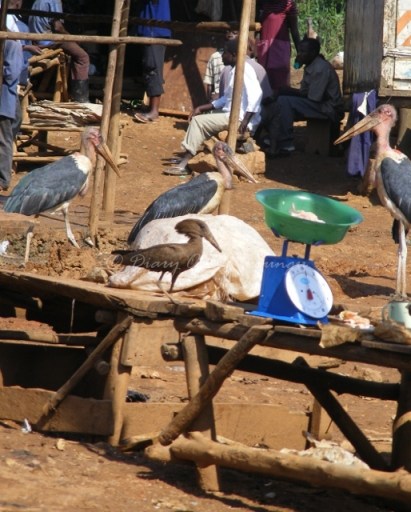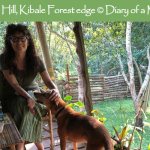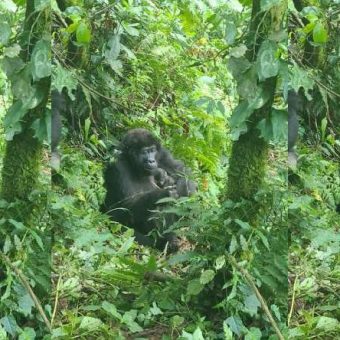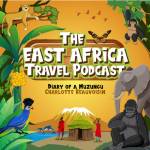
Looking for things to do around Kampala?
NatureUganda is a member organisation that organises affordable birdwatching trips around the country and researches numerous species, mainly birds.
Visiting the abattoir might not be top of every vegetarian’s wish list, but that didn’t stop two vegetarians from looking forward to a day out at the slaughterhouse, as part of Nature Uganda‘s annual vulture count. Interested in taking part?
Our gory tour took us to the very smelly outdoor Busega fish factory; the tidy, rustic Kyengera Abattoir and the formidable Kalerwe Abattoir, on the look-out for Hooded Vultures, Pied Crows, Brown Kites and Marabou Storks.

The annual Nature Uganda vulture count takes you to glamorous locations such as abattoirs! Here Marabou Storks congregate off Port Bell Road, Kampala
“I tried not to look at the blood and guts around me and looked down – and narrowly avoided stepping on a cow’s brain!” Said Alex the vegetarian. Not the most glamorous of day’s out for us ladies, tiptoeing around pools of dark red blood seeping into Kalerwe’s thick oozing mud…

My Nature Uganda friend Roger had painted a grim picture of last year’s annual vulture count – but I couldn’t wait to experience the horror for myself!
Living in Uganda has desensitised me to the horrors of the meat trade. A vegetarian since the age of 13, it was learning about the UK’s concrete and metal ‘factory farms’ that turned me off meat, overnight. In the UK we’re as far removed from the slaughter process as could possibly be (it’s hard to reconcile the surgical cleanliness of the plastic-wrapped portions of meat in the supermarket with the reality of what happens to the animal in the slaughterhouse). Here in Uganda, it’s back to basics: blood, guts and all.

Heaps of (cow) body parts wherever we looked in Kalerwe Abattoir, Kampala – why can’t the Chinese make ornaments and medicines out of this lot and leave Africa’s rhino and elephants alone?
So why were we putting ourselves through this?
Vultures aren’t the world’s prettiest birds – that characteristic bald head helps keep the head clean when feeding on a carcass – but they (and the Marabou Storks) are arguably the most useful, and need to be protected.
Populations of the eleven species of African vulture have declined considerably. Threats vary, but include poisoning, loss of habitat, trapping for food and witchcraft.
Vultures are nature’s most successful scavengers. Known by some as ‘Superman of the bird world,’ vultures can eat Anthrax (without dying) and quickly dispose of diseased carcasses (without catching the disease) – and no other animal will eat their carcass.
In the past decade, hundreds of vultures have been accidentally killed across East Africa after consuming poisoned animals set to kill lions and hyenas which had attacked livestock. Vultures are also intentionally poisoned by poachers because the presence of circling vultures alerts wildlife authorities to the location of poachers’ illegal activities.

Hooded Vulture soaring above Kampala. PHOTO Achilles Byaruhanga

Three Hooded Vultures, Kampala. PHOTO Veena Naik
In a recent incident, 48 vultures were poisoned near the Ishasha River on the Congo border, their bodies found scattered along a path heading back to Queen Elizabeth National Park.
In Kenya, vulture numbers in the Maasai Mara National Reserve have declined by an average of 62% since the 1970s. Vultures have some of the lowest reproductive rates among birds, making them particularly vulnerable. A decade ago none of Kenya’s eight vulture species was on the IUCN Red List of Threatened Species; now 6 out of 8 species are on the Red List, with populations declining at an alarming rate.
Information on Kenyan vultures edited from Summit to save Africa’s vulture populations from extinction on ‘African Raptors‘.

Hammerkop getting in on the act! Huge numbers of Marabou Storks overseeing the fish processing near Nateete, Kampala
So how is the demise of this ugly old bird linked to human health?
Following a decimation of the vulture numbers in India, there’s been an increase in disease transmission among dogs and rats. The subsequent increase in dogs and rabies is blamed for an estimated human health costs of $1.5 billion a year. If vulture numbers continue to decline in Kampala, what might be the impact on the residents of the city?

Too hot to trot! Nothing goes to waste here …molokony (cow hoof) is a popular hangover cure
Back at the abattoir, the authorities were suspicious of the muzungu wandering around with a camera – all except this guy: “You take my picture” he said.

My idea of hell – but just another day at work for this guy
Once beyond the understandably suspicious questions “are you from the Ministry of Health?” people seemed quite interested in what we were doing. Someone offered to feed the birds for us (for a fee). Another guy asked if we could solve the problem of the Marabous shitting on (and therefore destroying) his zinc roof!
At Kyengera, the unmistakable smell of burning flesh led us by the nose down to a shack where a whole cow’s head sat roasting on an open fire. For 500 shillings (the cost of two chapatis) I was invited to take a photo – or (just for laughs!) pose with the man stoking the fire and roasting the head – somehow that just seemed one step too far.
Aren’t you glad I didn’t take that last photo?
The species: in order of population size, Uganda has the following Vultures: White-backed, Hooded, Ruppell’s, Palm Nut, Lappet-faced, White-headed and Egyptian.
To learn more about the Kampala vulture counts, and other activities, visit the Nature Uganda web site.




























Wow Cha. That trip was almost heroic of you but totally absorbing. I have always been disgusted if not scared by vultures – ever since seeing on my first ever trip to the cinema – a film in Technicolor all about wildlife in Africa. I forget the name, but it was something of a seminal full length feature film I think and fantastic to me at the age of 8 or 9. I learned a lot from your piece and, yes, I am now feeling sorry for them. On a constructive note I did wonder if you should perhaps make it clear that the many cattle horns on view are not rhino horns or elephant tusks though? This is real down and dirty journalism isn’t it? Awesome!
Pa, vultures get a bad press, I’m a big fan of them, now more than ever!
Ma had a good suggestion: why can’t the Chinese use cow horns for medicine (rather than rhino horn, tiger’s penis, etc etc)?
Hey Cha, great story as ever.. and you know me love the bit about the Marabous and the zinc roof. I love the fact that meat eaters will read this and think it’s grose and vile. However, us no meat eaters will just get on with it. Humm thinking I need to come back and work in your office with you. You get to do some amazing work!
Funny isn’t it, how the meat eaters are all freaked out by the abattoir sights? Us veggies have got our head around the reality I think!
Would love you to come visit. My main ‘office’ is my spare room now (the previous one was in an uninspiring underground car park!) and I just write the blog/ volunteer for fun – or is it an obsession? Probably the latter! I’m still very lucky tho 🙂
Hi Muzungu, this is a wonderful story. I can really feel your disgust. And the pictures, hhmmmmm. Not sure I can stand that. That is why I usually count the Kitezi rubbish dump, which is a more disgusting site but at least without blood all over the ground. The most amazing site at Kitezi is usually the line of dead dogs with bulging stomachs and the Vultures near by waiting for the first dog skin to be opened!
Hi Dianah, thanks for reading (but maybe not enjoying!) this post. I know we were there to count birds, but I couldn’t help focusing on the abattoir itself. They are never nice places, wherever you go. The line of dead dogs at Kitezi sounds pretty awful (I suppose they are strays?) – I dare say I may end up there next year on the vulture count then! But at least the vultures appreciate them – just shows what a useful service these birds provide to the people of Kampala.
Dianah, what happens to all the old cow horns, do you think? I know some are made into (quite beautiful) ornaments like drinks mats, jewellery, etc, but are they all (re)used?
I love vultures. Very interesting post. The picture of the Hamerkop cracks me up… 🙂
That’s one cheeky little Hammerkop isn’t it? “Hey guy – we’re not here to count you!!”
Vultures are very cool – I love your photo of the Egyptian Vultures. Great blog Amy!
Another year our Vulture Count team travelled – in the rain – to the abattoir along Old Port Bell! Surprisingly good fun! Read the story on the NatureUganda blog
I feel like I’ve just seen this disgustingness article for the first time. I must have read it before. My comment is that you make it interesting and fun! Can’t say it is on my bucket list though. As a vegetarian you were very brave to set foot (squish) in the place. May be now you would find it easier??! ho ho!!
Visiting an abattoir in Kampala is like being on the set of the worst horror movie imaginable. You might call it morbid curiosity that drove this once-vegetarian to visit!
But you know me, I love birds and that was the attraction: trying to see how many vultures we could count…
“Are you from the ministry of health” ?
lol Ronnie
Birders get asked the funniest questions – one time I was with Nature Uganda in the grounds of Makerere University. The guard was very suspicious of us and our binoculars. “You are spies! You can see up to Jinja!” he said.
Forget the stench, focus on the vultures!
I had to go back and do the vulture count another year. Here’s a story I wrote for David Lindo ‘The Urban Birder’ entitled ‘Counting vultures around abattoirs in Kampala, Uganda’ https://theurbanbirderworld.com/counting-vultures-around-abattoirs-in-kampala-uganda/